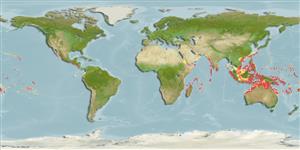Actinopterygii (ray-finned fishes) >
Scorpaeniformes (Scorpionfishes and flatheads) >
Platycephalidae (Flatheads)
Etymology: Thysanophrys: Greek, thysanos = tassel + Greek, ophrys = eye brow (Ref. 45335). More on author: Schultz.
Environment / Climate / Range
Ecology
Marine; reef-associated; non-migratory; depth range 0 - 100 m (Ref. 9710), usually 0 - 20 m (Ref. 92868). Tropical, preferred ?; 30°N - 24°S
Indo-Pacific: common and wide-ranging, from the Western Indian Ocean to Japan and Pacific Ocean islands to as far as the Marquesas.
Size / Weight / Age
Maturity: Lm ? range ? - ? cm
Max length : 25.0 cm TL male/unsexed; (Ref. 48635); common length : 18.0 cm TL male/unsexed; (Ref. 30573)
Dorsal
spines
(total): 8 - 9;
Dorsal
soft rays
(total): 11-12;
Anal
spines: 0;
Anal
soft rays: 12. Body and head mottled with dark brown and buff; fin rays with dark brown or black spots; dark brown saddle blotch on top of caudal peduncle (Ref. 4315). Least interorbital width going 3.8-7.2 times in diameter of eye. Base of lower opercular spine concealed by scales. Anterior 1-3, usually 3, lateral line scales bearing a small spine. Iris lappet bearing short branches with bifurcate tips.
Inhabits sand areas adjacent to coral reefs (Ref. 9790). Seldom noticed for it buries itself in the sand (often partially). Usually in small groups (Ref. 48635). Feeds on crustaceans, crabs and prawns, also on fishes.
Life cycle and mating behavior
Maturity | Reproduction | Spawning | Eggs | Fecundity | Larvae
Randall, J.E., G.R. Allen and R.C. Steene, 1990. Fishes of the Great Barrier Reef and Coral Sea. University of Hawaii Press, Honolulu, Hawaii. 506 p. (Ref. 2334)
IUCN Red List Status (Ref. 115185)
CITES (Ref. 94142)
Not Evaluated
Threat to humans
Harmless
Human uses
Fisheries: subsistence fisheries
More information
Common namesSynonymsMetabolismPredatorsEcotoxicologyReproductionMaturitySpawningFecundityEggsEgg development
ReferencesAquacultureAquaculture profileStrainsGeneticsAllele frequenciesHeritabilityDiseasesProcessingMass conversion
Tools
Special reports
Download XML
Internet sources
Estimates of some properties based on models
Phylogenetic diversity index (Ref.
82805): PD
50 = 0.5010 [Uniqueness, from 0.5 = low to 2.0 = high].
Bayesian length-weight: a=0.00631 (0.00367 - 0.01084), b=3.07 (2.91 - 3.23), in cm Total Length, based on LWR estimates for this species & (Sub)family-body (Ref.
93245).
Trophic Level (Ref.
69278): 3.8 ±0.63 se; Based on food items.
Resilience (Ref.
69278): High, minimum population doubling time less than 15 months (Preliminary K or Fecundity.).
Vulnerability (Ref.
59153): Low to moderate vulnerability (25 of 100) .
